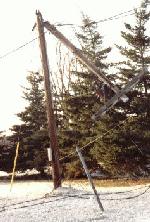 |
 |
 |
| This is the view that greeted us as we looked out of the fire station on the first day of the storm. Trees almost universally
suffered this type of damage. |
The view down School Street past our station. The green building was our Firemen's Hall, which housed some who were
without other shelter, but which chiefly served a lot of meals, to residents and utility crews alike. Over 3000 meals were served
over the course of the disaster. |
Looking south on NYS Route 12 a mile north of Depauville. Note the ice on the sign, and the deep sag of the power
lines. These poles were eventually pulled down by the load of the ice.
|
 |
 |
 |
| Chain link fence became glass block walls as the ice accumulated. This was the scene at Guardino Elementary School
in the village of Clayton. |
This chunk of ice was hanging UNDER a power line. The ruler shows it to be 2" in diameter. That works out to about
a pound per linear foot, and that weight doesn't include the ice that was actually around the wire. You do the math... |
The massing of the utility company vehicles at lunch time. The crews enjoyed our hot meals much more than the
box lunches they were provided. The Army's 10th Mountain Division supplied two "water buffalos" for drinking water along
with a generator and two operators for our station. |
 |
 |
| This pole provided part of the inspiration for our Ice Storm '98 patch. It was very typical. Over 8000 poles were lost during the storm.
| Hancock's Patch. |

